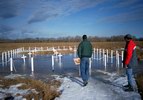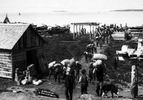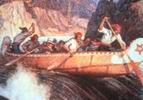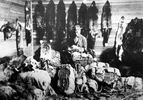|
Analysis
of musculo-skeletal stress indicators was conducted on the
skeletons of individuals who lived during the Fur Trade
Period at two locations in Alberta: the Seafort Burial Site,
near Rocky Mountain House; and the Rossdale Site, in the
city of Edmonton.
Seafort
The Seafort Burial Site, discovered in the spring of 1969
by workers for Seafort Petroleum, is believed to be associated
with one of the five fur trade posts that were located near
Rocky Mountain House between 1799 and 1875. Upon the discovery
of the site, the Department of Anthropology at the University
of Alberta was asked to undertake rescue excavations of
the remains of 14 individuals, recovered from 12 graves.The
excavations were completed in 1971.
| This
area was designated as a National Historic Park in 1979,
and the remains of 12 individuals were reinterred at
the site shortly after their discovery that year. |
|
The
skeletons recovered between 1969 and 1971, and their associated
grave goods, were reburied at the National Historic site
in October, 2002, through the collaboration of the University
of Alberta (Department of Anthropology and Department of
Museums and Collections Services), the Rocky Mountain House
Métis Association, the Métis Nation of Alberta,
and Parks Canada.
|
Rossdale
The discovery of human skeletal remains in the Rossdale
area of Edmonton date back many years. It was not
until the discovery of graves in 1967 by workers at
the Rossdale power plant that the Department of Anthropology
at the University became involved. Archaeologists
undertook to rescue the remains of six individuals
(one in February or March and another five in July),
in what was thought to be a cemetery associated with
historic Fort Edmonton. The skeletal remains and their associated grave goods were reburied at Rossdale in August, 2005, through the collaboration of the University of Alberta (Department of Anthropology and Department of Museums and Collections Services), the City of Edmonton, and Lifeways of Canada.
|
|





